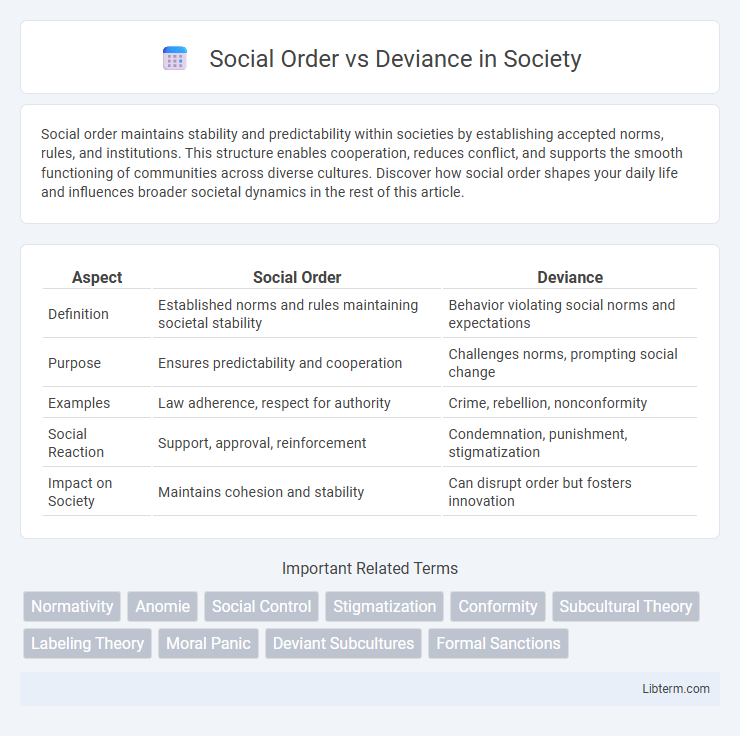Social order maintains stability and predictability within societies by establishing accepted norms, rules, and institutions. This structure enables cooperation, reduces conflict, and supports the smooth functioning of communities across diverse cultures. Discover how social order shapes your daily life and influences broader societal dynamics in the rest of this article.
Table of Comparison
| Aspect | Social Order | Deviance |
|---|---|---|
| Definition | Established norms and rules maintaining societal stability | Behavior violating social norms and expectations |
| Purpose | Ensures predictability and cooperation | Challenges norms, prompting social change |
| Examples | Law adherence, respect for authority | Crime, rebellion, nonconformity |
| Social Reaction | Support, approval, reinforcement | Condemnation, punishment, stigmatization |
| Impact on Society | Maintains cohesion and stability | Can disrupt order but fosters innovation |
Defining Social Order and Deviance
Social order refers to the organized set of social structures, norms, and rules that maintain stability and predictability within a society, ensuring cooperation and conformity among its members. Deviance involves behaviors or actions that violate these established social norms and expectations, challenging the prevailing social order. Sociologists analyze both concepts to understand how societies enforce rules and respond to norm-breaking conduct.
Theoretical Perspectives on Social Order
Theoretical perspectives on social order emphasize how different frameworks explain the maintenance of stability and control in society, contrasting with the concept of deviance as a violation of social norms. Structural functionalism views social order as a system of interrelated parts working together, where deviance serves to reinforce collective norms and promote social cohesion. Conflict theory argues that social order is maintained by dominant groups using power and control, labeling deviance as behavior that challenges inequalities and threatens established hierarchies.
Origins and Causes of Deviance
Deviance originates from complex social processes including strain theory, which argues that societal pressure to achieve culturally approved goals without equal access to legitimate means leads to deviant behavior. Conflict theory highlights how power disparities and social inequality result in laws and norms that label marginalized groups as deviant to maintain dominant control. Symbolic interactionism emphasizes the role of social interaction and labeling in the development of deviant identity, where individuals internalize deviant labels imposed by society.
Social Norms: Foundation of Order
Social norms serve as the foundation of social order by establishing shared expectations and acceptable behaviors within a community. These unwritten rules guide individual actions, promoting predictability and cohesion essential for societal stability. Deviance occurs when individuals violate these norms, challenging the social order and often prompting mechanisms of control or correction.
Mechanisms of Social Control
Mechanisms of social control enforce social order by regulating individual behavior through formal institutions like laws, law enforcement, and the judicial system, as well as informal means such as norms, customs, and peer pressure. Social control mechanisms operate to deter deviance by establishing consequences for rule-breaking, maintaining conformity, and reinforcing societal values and norms. The balance between social order and deviance is maintained through the continuous application of these control mechanisms, which shape acceptable conduct and limit disruptions to social stability.
Types and Forms of Deviance
Deviance encompasses a range of behaviors that violate social norms, including formal deviance such as criminal acts and informal deviance like unconventional dress or speech. Types of deviance include primary deviance, which involves isolated acts that do not affect an individual's self-concept, and secondary deviance, characterized by repeated violations resulting in a labeled deviant identity. Forms of deviance vary across cultures and societies, reflecting differing moral codes and legal systems that define acceptable behavior and social control mechanisms.
The Role of Institutions in Enforcing Order
Institutions such as the legal system, educational bodies, and law enforcement agencies play a critical role in maintaining social order by establishing norms, enforcing laws, and punishing deviant behavior. These entities work collaboratively to uphold societal values, deter criminal activities, and promote conformity through structured regulations and sanctions. By reinforcing accepted behaviors and addressing violations, institutions help stabilize communities and prevent social chaos.
Consequences of Deviance on Society
Deviance disrupts social order by challenging established norms and creating instability within communities. The consequences of deviance include increased social tension, erosion of trust, and strain on legal and social institutions tasked with maintaining control and enforcing consequences. Persistent deviance can lead to social fragmentation and hinder cohesive societal development.
Social Change: From Deviance to Norm
Social change often originates from deviant behaviors that challenge established norms, leading to a redefinition of what is considered acceptable or unacceptable within a society. Deviance acts as a catalyst by highlighting societal issues and prompting shifts in cultural values, laws, and social practices. Over time, actions once labeled deviant can transform into new social norms, reflecting evolving collective attitudes and social structures.
Balancing Social Order and Individual Freedom
Balancing social order and individual freedom involves maintaining societal norms while respecting personal autonomy. Effective legal frameworks and community standards create boundaries that prevent deviance without stifling individual rights. This equilibrium is essential for fostering a stable society where diversity of thought and behavior coexist with social cohesion.
Social Order Infographic

 libterm.com
libterm.com